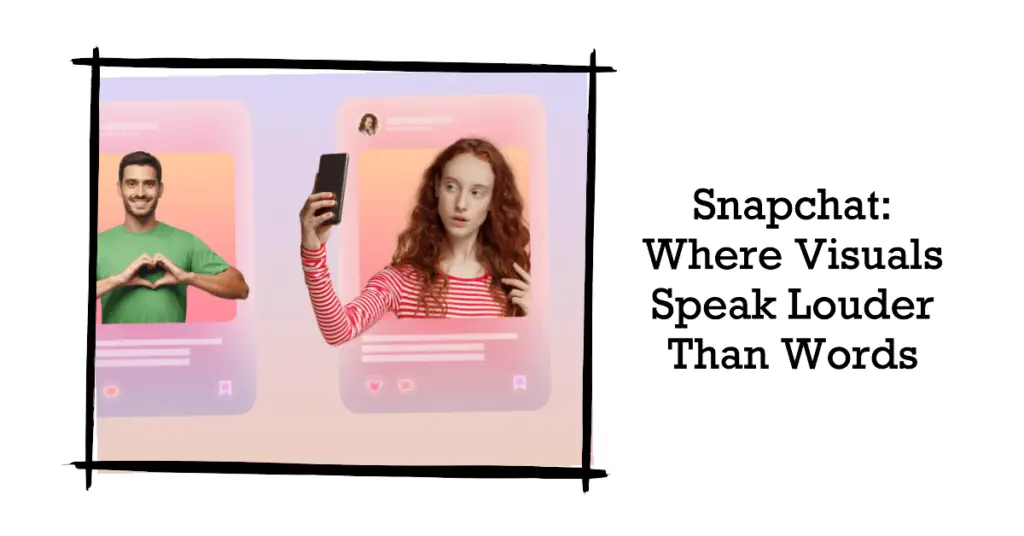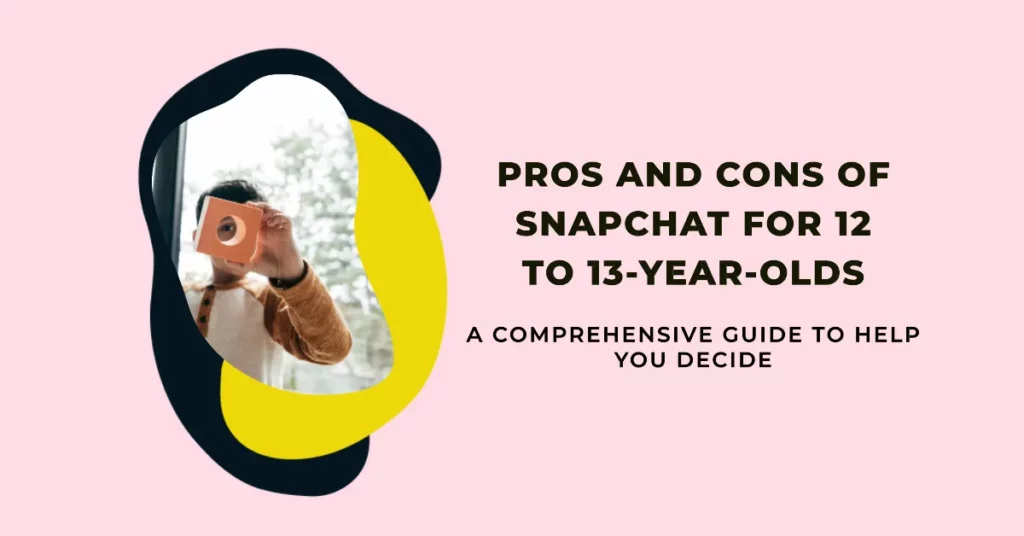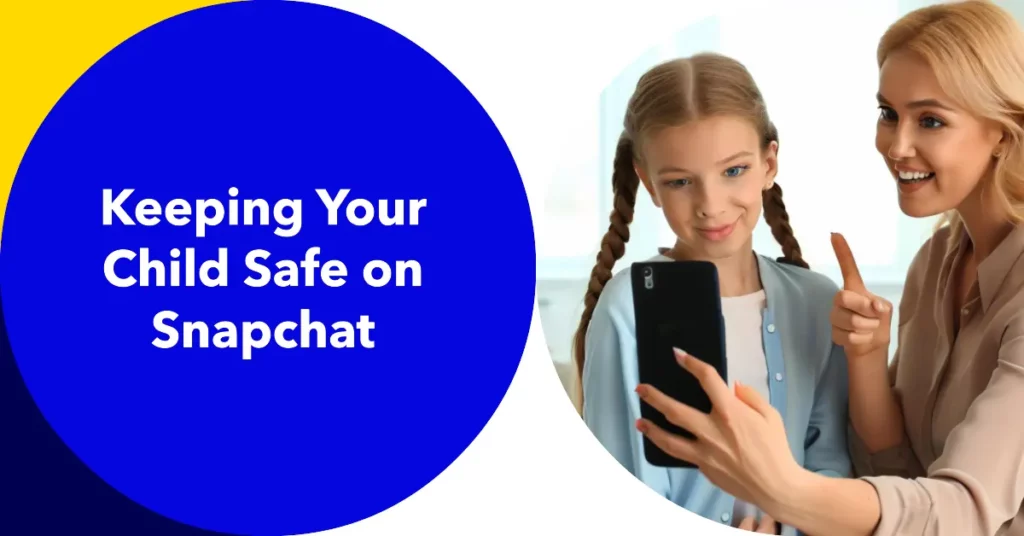In an era where social media reigns supreme, choosing the right platform to connect, communicate, and share your life can be a real head-scratcher.
Whether you’re a casual user aiming to stay in touch with friends, or a brand looking to build a robust online presence, each platform has unique features and drawbacks.
Snapchat, the photo and video-sharing app beloved by many, especially younger audiences, is no exception.
Snapchat’s ephemeral content approach with disappearing messages, the charm of fun filters, and the streaks can seem appealing.
However, the platform’s interface can be perplexing to new users. Furthermore, the fleeting nature of content presents unique challenges for those looking to make a lasting impact or to use the platform for business purposes.
Does Snapchat’s focus on ‘the here and now’ affect its potential to attract a broader audience or engage users long-term? Is the platform’s privacy as transient as its content?
This comprehensive guide dives deep into the pros and cons of Snapchat, arming you with the knowledge to decide whether this social media platform aligns with your personal or brand objectives.
We’ll explore the unique features that make Snapchat stand out from its competitors, assess potential drawbacks, and provide some illustrative case studies to help you make the most informed decision.
Let’s decode the enigma that is Snapchat together.
Background of Snapchat
A popular multimedia messaging app, Snapchat has an intriguing background that has captivated millions worldwide.
Launched in 2011 by Evan Spiegel, Bobby Murphy, and Reggie Brown, Snapchat originated as a project during their time at Stanford University.
The app’s primary feature, disappearing photos and videos, quickly garnered attention and set it apart from traditional messaging platforms.
Snapchat’s innovative approach to communication sparked a new era of digital interaction.
With its ephemeral nature, the app revolutionized how users shared moments by allowing them to send self-destructing content, fostering a sense of intimacy and spontaneity.
This unique concept resonated strongly with a younger audience, leading to rapid growth and widespread adoption.
Over the years, Snapchat has expanded its offerings, introducing features such as Snap Map, Discover, and Snapstreaks.
Snap Map provides users with real-time location sharing, enabling friends to see each other’s whereabouts. Discover showcases content from publishers, including news articles, entertainment, and lifestyle pieces.
Snapstreaks, on the other hand, encourage users to maintain a consecutive exchange of snaps, fostering engagement and stickiness on the platform.
Snapchat’s privacy-focused approach also contributed to its success. The app notifies users when someone takes a screenshot of their content, promoting a trustworthy environment for sharing. Moreover, the implementation of end-to-end encryption further safeguards user data.
Today, Snapchat continues to evolve with new features, filters, and lenses, constantly redefining the boundaries of social media.
Its captivating background and commitment to innovation have solidified its position as a leading platform for creative expression and authentic communication.
Overview of Snapchat Features
Snapchat, a dynamic multimedia messaging app, offers many innovative features that have captivated users worldwide.
With its unique blend of ephemeral content and interactive tools, Snapchat has become a go-to platform for sharing moments authentically and engagingly.
At the heart of Snapchat’s features is the ability to send disappearing photos and videos. This ephemeral nature adds an element of excitement and privacy to communication, allowing users to share candid snippets of their lives without the fear of permanent records.
Snapchat’s AR-powered lenses and filters take creativity to the next level. Users can transform their appearances, overlay playful animations, and even turn their surroundings into immersive experiences. These interactive elements have made Snapchat a hub for viral trends and creative expression.
The platform also boasts various engaging features like Snap Map, which allows users to share their location with friends in real-time, and Discover. In this curated section, users can explore various content from publishers, influencers, and creators.
Additionally, Snapchat introduced Snapstreaks, a feature that motivates users to maintain a consecutive exchange of snaps with friends, fostering loyalty and frequent engagement on the platform.
Snapchat’s commitment to privacy is evident through features such as notifying users when someone takes a screenshot of their content and implementing end-to-end encryption to protect user data.
In conclusion, Snapchat’s diverse and dynamic range of features provides users with an exciting and personalized social media experience.
Whether through disappearing messages, AR lenses, or interactive maps, Snapchat continues to push the boundaries of digital communication and redefine how we share our lives.
Pros and cons of Snapchat – A Comparision
Pros of Snapchat 👍
1. Ephemeral Content
Snapchat’s ingenious approach to disappearing content has revolutionized how users engage with social media platforms, ensuring a fresh and engaging feed.
By incorporating the element of transience, Snapchat has created a unique user experience that fosters a sense of urgency and authenticity.
The ephemeral nature of Snapchat’s disappearing content makes every post feel fleeting, encouraging users to stay active and keep up with the ever-changing feed.
Unlike other platforms where posts are eternally visible, Snapchat’s approach creates a sense of exclusivity and scarcity.
The ephemeral aspect also promotes spontaneity and unfiltered sharing. Users feel more comfortable expressing themselves, knowing that their posts will vanish into thin air.
This drives users to share moments and experiences in real-time without fearing their content being permanently recorded.
Snapchat’s disappearing content also facilitates a dynamic and ever-evolving feed. Users can browse various content ranging from playful snaps to behind-the-scenes glimpses, ensuring a diverse and engaging experience.
The knowledge that content will disappear soon adds an element of excitement, compelling users to check the app regularly to avoid missing out.
Moreover, Snapchat’s engaging features, such as filters, lenses, and augmented reality (AR), add an extra layer of interactivity to the disappearing content.
Users can transform their appearances, overlay animations, and engage with immersive experiences. This further enhances the freshness and appeal of the feed, keeping users coming back for more.
In conclusion, Snapchat’s unique utilization of disappearing content creates a consistently fresh, engaging feed full of surprises.
By embracing transience, Snapchat encourages spontaneous sharing, promotes exclusivity, and offers a dynamic user experience that sets it apart from other social media platforms.
2. Visual Communication
Snapchat, the trailblazing multimedia messaging app, places a significant emphasis on visual messages, elevating the power of imagery in digital communication.
Unlike traditional text-based platforms, Snapchat recognizes the profound impact of visuals in conveying emotions, storytelling, and fostering connections.
At the core of Snapchat’s appeal lies its primary medium: visual messages. Users can instantly capture and share photos and videos, utilizing various creative tools and filters to enhance their content.
This emphasis on visuals enables users to express themselves with greater depth and nuance, transcending the limitations of text alone.
Snapchat’s innovative features, such as AR lenses and filters, further enhance the visual experience.
These interactive elements allow users to overlay animations, distort reality, and transform their appearances, infusing visual messages with an extra layer of engagement and entertainment.
Moreover, Snapchat’s Stories feature provides a captivating platform for users to curate a series of visual messages, forming a narrative that can be shared with friends and followers.
This narrative format facilitates immersive storytelling, allowing users to convey experiences and moments more compelling and immersively.
The emphasis on visual messages in Snapchat promotes a sense of authenticity and visual communication. By relying on images, users can capture the essence of a moment, share their perspectives, and evoke emotions with greater impact.
This visual-centric approach has contributed to Snapchat’s widespread popularity, particularly among younger generations who value creativity and self-expression.
In conclusion, Snapchat’s emphasis on visual messages recognizes the power of imagery in digital communication.
By providing a platform that celebrates and amplifies visual expression, Snapchat enables users to communicate in a more vibrant, engaging, and visually captivating manner.
3. Filters and Lenses
Snapchat’s augmented reality (AR) filters have taken the world by storm, captivating users with their popularity and adding a touch of magic to the app.
These interactive and dynamic filters have become synonymous with Snapchat, transforming how users express themselves and engage with the platform.
The popularity of Snapchat’s AR filters can be attributed to their ability to merge the real and digital worlds seamlessly.
These filters utilize advanced computer vision technology to map and track users’ faces, allowing them to overlay playful animations, effects, and transformations onto their selfies.
This immersive experience has created a new form of self-expression, where users can become adorable animals, don whimsical accessories, or transport themselves to imaginative landscapes.
Snapchat’s AR filters have gained widespread appeal due to their innovative nature. With a constant stream of new filters released, users are continually enticed to experiment and share their experiences.
This ever-evolving library of filters keeps the platform fresh and engaging, offering users a sense of novelty and excitement.
The interactive nature of these filters encourages user participation, sparking a wave of viral trends and challenges.
From dancing hot dogs to face-swapping capabilities, Snapchat’s AR filters have become a cultural phenomenon, driving engagement and fueling creativity.
Furthermore, the shareability of AR-filtered content contributes to their popularity. Snapchat allows users to effortlessly share their filtered photos and videos with friends and followers, creating a ripple effect of engagement and amplifying the reach of these filters.
In conclusion, Snapchat’s AR filters have become popular by revolutionizing self-expression, providing an immersive experience, and fostering a vibrant community.
Their innovative and interactive nature and shareability have propelled them to become a defining feature of the Snapchat platform, captivating users and ensuring their continued relevance in the ever-evolving social media landscape.
4. Privacy
Snapchat, the popular multimedia messaging app, has carved its niche by offering users enhanced privacy through the ingenious features of disappearing content and screenshot notifications.
These features have revolutionized the way users share and communicate, providing a greater sense of control over their digital footprint.
Snapchat’s disappearing content feature allows users to send photos and videos that vanish after viewing, adding privacy to conversations.
By ensuring that content is not permanently stored, Snapchat empowers users to confidently share moments, knowing their content will not linger or be subject to unwanted scrutiny.
The platform’s screenshot notifications feature further reinforces privacy by alerting users when someone takes a screenshot of their content.
This notification system promotes transparency, letting users know if their messages or images are captured and shared without their consent. This feature is a deterrent, discouraging the misuse or unauthorized distribution of private content.
Snapchat’s emphasis on enhanced privacy aligns with its commitment to user trust and security. By providing clear indicators of disappearing content and notifying users of screenshots, Snapchat creates a safer environment for sharing personal moments and sensitive information.
These privacy-centric features have resonated with users, especially those who value control over their online presence.
The disappearing content and screenshot notifications on Snapchat offer a sense of security, allowing users to express themselves more openly and authentically.
In conclusion, Snapchat’s implementation of disappearing content and screenshot notifications addresses users’ privacy concerns uniquely and effectively.
By offering enhanced control and transparency, Snapchat empowers users to communicate and share moments with a heightened sense of privacy and security.
These features have become integral to the platform’s appeal, fostering a trustworthy and private environment for its global community of users.
5. Engagement with Younger Audience
Snapchat has emerged as a social media powerhouse, captivating the attention of younger demographics and solidifying its position as a platform of choice for this tech-savvy generation.
The app’s popularity among young users can be attributed to unique features, engaging content, and an innate understanding of their preferences.
Snapchat’s ephemeral nature and disappearing content have struck a chord with younger demographics.
This generation values authenticity, spontaneity, and privacy, and Snapchat’s platform allows them to express themselves freely without the fear of permanent records or judgment.
The fleeting nature of Snapchat’s messages aligns with their desire for immediate and transient interactions.
The platform’s vibrant and interactive features, such as AR lenses, filters, and Bitmojis, provide a playground for creativity and self-expression.
Snapchat empowers young users to transform their appearance, overlay animations, and engage with immersive experiences. This dynamic and visually appealing content resonates with their desire for entertainment and engagement.
Snapchat’s engaging content ecosystem, including Discover and Snap Originals, offers curated and original content that caters to various interests.
From news articles to entertainment, lifestyle, and influencer content, Snapchat ensures there is something for everyone within its platform.
The app’s popularity among younger demographics is also driven by its emphasis on privacy and digital well-being. Snapchat notifies users when someone takes a screenshot of their content, fostering a sense of trust and security.
Additionally, the app’s focus on limiting public metrics like likes and follower count reduces the pressures associated with social validation.
In conclusion, Snapchat’s success among younger demographics results from its understanding of their preferences for privacy, authenticity, and creative expression.
With its ephemeral nature, engaging features, diverse content offerings, and commitment to digital well-being, Snapchat has captured the hearts of this generation, making it their go-to platform for social interaction and self-expression.
6. Business Opportunities
Snapchat, the dynamic multimedia messaging platform, offers an array of opportunities for businesses to leverage its unique features and engaged user base for marketing and advertising purposes.
By tapping into Snapchat’s creative tools and targeting capabilities, businesses can effectively reach and engage with their target audience distinctively and interactively.
One of the primary ways businesses can leverage Snapchat is through Snap Ads, short video ads that appear within the app’s content.
These ads provide an opportunity to deliver concise and visually captivating messages to users, grabbing their attention amid their Snapchat experience.
Moreover, Snapchat’s sponsored lenses and filters offer businesses an avenue for immersive and interactive branding experiences.
By designing branded augmented reality (AR) experiences, businesses can drive engagement and create memorable moments that resonate with users, encouraging them to interact and share the branded content.
Another powerful feature for businesses is Snapchat Discover, which enables publishers and brands to share engaging content.
By partnering with publishers or creating their content channels, businesses can showcase their products, services, and stories to a wider audience, establishing themselves as thought leaders and enhancing brand awareness.
Snapchat’s audience targeting capabilities also provide businesses with an advantage. By leveraging demographic, interest-based, and location-based targeting options, businesses can ensure their ads reach the most relevant audience, optimizing the impact of their marketing campaigns.
In conclusion, Snapchat offers businesses a unique platform to connect with their target audience through various advertising and marketing opportunities.
Businesses can effectively engage users, enhance brand visibility, and drive conversions by leveraging Snap Ads, sponsored lenses and filters, Snapchat Discover, and audience targeting capabilities.
Snapchat’s innovative features and engaged user base make it an appealing channel for businesses seeking to expand their reach and make a lasting impression in the digital landscape.
Cons of Snapchat 👎
1. Limited Audience
While Snapchat has enjoyed immense popularity among certain population segments, it also faces limitations in its demographic reach.
The platform’s appeal primarily lies with younger audiences, and this narrow demographic focus can pose challenges for businesses and marketers seeking to reach a broader target market.
Snapchat’s demographic reach is most pronounced among Millennials and Generation Z users, who are drawn to the app’s ephemeral and visually engaging features.
However, older demographics, such as Baby Boomers and Gen X, have shown comparatively lower adoption rates on the platform.
This demographic limitation can affect businesses’ marketing strategies, as their target audience may not align with Snapchat’s user base.
It becomes crucial for marketers to assess whether Snapchat aligns with their desired demographic profile before investing resources into the platform.
Furthermore, Snapchat’s demographic reach is influenced by regional and cultural factors. While the app enjoys significant popularity in certain countries, its adoption may be limited in others.
Local preferences and cultural nuances can impact the platform’s appeal and restrict its demographic reach in specific regions.
In response to these limitations, businesses should consider diversifying their marketing efforts across multiple platforms to ensure a broader demographic reach.
Integrating Snapchat with other social media channels can help reach a wider audience and create a more comprehensive marketing strategy.
In conclusion, while Snapchat’s unique features have attracted a dedicated following among younger demographics, the platform faces limitations in its demographic reach.
Businesses and marketers must carefully consider the alignment between their target audience and Snapchat’s user base to make informed decisions about including the platform in their marketing mix.
Diversification across multiple platforms is key to achieving a broader demographic reach and maximizing marketing effectiveness.
2. Ephemeral Content
While disappearing content on platforms like Snapchat may have its allure, it also presents a few cons that can pose challenges for businesses and marketers, particularly when building long-term content strategies.
One of the main drawbacks of disappearing content is its difficulty establishing a sustainable and persistent presence. Traditional content strategies often focus on creating evergreen content that can be accessed and referred to over time.
However, with disappearing content, the ephemeral nature limits the lifespan and discoverability of the content, making it challenging to build a cohesive and long-lasting content strategy.
Moreover, the fleeting nature of disappearing content can lead to limited exposure and engagement.
Unlike permanent content that can be shared, revisited, and built upon, disappearing content has a shorter lifespan, reducing the opportunities for users to interact with and share the content, which can impact a marketing campaign’s overall reach and effectiveness.
Additionally, the absence of a tangible content archive can hinder businesses from analyzing and iterating on their content strategies.
Gathering insights, identifying trends, and refining future content becomes more challenging without a comprehensive and accessible record of past content performance.
Overcoming these cons requires businesses to balance ephemeral and enduring content strategies.
This may involve combining disappearing content with long-term content initiatives on other platforms, creating supplementary content that adds value beyond the temporary nature of the disappearing content, or incorporating elements that encourage users to capture and share the content outside the platform.
In conclusion, while disappearing content offers unique opportunities for spontaneous and engaging interactions, it presents cons in building long-term content strategies.
The ephemeral nature, limited exposure, and difficulties in analysis necessitate a thoughtful approach to ensure a balanced content strategy that aligns with the business objectives and target audience.
3. Complexity
Snapchat’s unique interface and features can challenge new users seeking to navigate the app easily. With its emphasis on ephemeral content, augmented reality filters, and disappearing messages, Snapchat has carved out a distinct niche in social media platforms. However, this uniqueness can initially perplex those unfamiliar with its intricacies.
Firstly, Snapchat’s interface deviates from traditional social media layouts, making it harder for newcomers to grasp its functionalities intuitively.
Unlike linear timelines, Snapchat employs a swipe-based navigation system, where each swipe reveals different sections and features. This non-linear approach can be disorienting for users accustomed to more conventional interfaces.
Moreover, Snapchat’s disappearing nature of messages and stories may confuse newcomers. The app’s emphasis on temporary content requires users to adapt to a different mindset—understanding that content shared on Snapchat has a limited lifespan.
This ephemeral aspect may create uncertainty and anxiety for new users, who may fear missing out or struggling to keep up with the constant updates.
Furthermore, Snapchat’s unique features, such as Snap Map, Discover, and Snapstreaks, can overwhelm new users. These features are not commonly found in other social media platforms, which adds to the learning curve. Understanding the purpose and functionality of each feature demands time and exploration.
In conclusion, Snapchat’s distinctive interface and features can pose difficulties for new users. The non-linear navigation, the ephemeral nature of the content, and the plethora of unique features all contribute to the initial challenges those entering the Snapchat ecosystem face.
However, with patience, experimentation, and a willingness to adapt, users can gradually unravel the intricacies of this dynamic platform and harness its full potential for self-expression and communication.
4. Privacy Concerns
Snapchat, known for its innovative features and emphasis on ephemeral content, has faced scrutiny regarding privacy concerns, particularly the perception of “transient” security. While the app offers unique functionalities, it also presents potential challenges for user privacy.
One notable concern is the ephemeral nature of Snapchat’s content. Although messages and stories disappear after a certain period, users may be unaware that recipients can take screenshots or use other methods to save content without the sender’s knowledge.
This perception of transient security can lead to a false sense of privacy, potentially resulting in the unintended dissemination of sensitive information.
Another privacy consideration is Snapchat’s collection of user data. As with many social media platforms, Snapchat gathers significant user information for targeted advertising.
While the app assures users of their data protection measures, the potential for data breaches and misuse of personal information remains a concern.
Additionally, using geolocation features in Snapchat, such as Snap Map, raises privacy questions. While these features can enhance user experiences by providing location-based content, they expose users to potential risks, such as revealing their whereabouts to a larger audience or unauthorized individuals.
To address these concerns, Snapchat has enhanced user privacy by introducing end-to-end message encryption and implementing stronger security measures.
However, it remains essential for users to be vigilant, exercise caution when sharing personal information, and regularly review and adjust their privacy settings to align with their comfort levels.
In conclusion, while Snapchat offers a unique and engaging platform for communication and self-expression, users must be aware of the potential privacy concerns. When utilizing the app, the perception of “transient” security, data collection practices, and geolocation features should be considered.
Users can navigate Snapchat’s digital landscape with greater peace of mind by understanding the implications and taking proactive measures to protect their privacy.
5. Metrics and Analysis
Tracking Snapchat’s metrics can present unique challenges compared to other platforms, making it important for marketers and analysts to understand the intricacies involved.
One of the difficulties lies in Snapchat’s limited analytics. Snapchat’s metrics are more restricted than other social media platforms offering robust and comprehensive analytics tools.
While it provides basic insights such as views and screenshots, it lacks in-depth data on user engagement, demographics, and audience behavior. This limitation makes it harder for businesses to measure their Snapchat campaigns’ effectiveness accurately.
Another challenge is the ephemeral nature of Snapchat’s content. As messages and stories disappear, tracking long-term engagement and performance becomes challenging.
Unlike platforms where content remains accessible, Snapchat’s transient nature requires marketers to focus on immediate impact rather than long-term tracking.
Furthermore, Snapchat’s privacy measures can affect metric tracking. The platform prioritizes user privacy by implementing end-to-end encryption and limited data sharing.
While these measures are commendable for protecting user information, they can limit the accessibility of data for marketers, making it harder to gain valuable insights.
Additionally, Snapchat’s closed ecosystem presents tracking difficulties. Unlike platforms that allow third-party integrations and tracking tools, Snapchat maintains a more controlled environment. This can limit the integration of external analytics tools and hinder comprehensive cross-platform tracking.
In conclusion, tracking metrics on Snapchat can be more challenging than on other platforms. Limited analytics, the ephemeral nature of the content, privacy measures, and a closed ecosystem all contribute to these difficulties.
However, marketers can still derive valuable insights to optimize their Snapchat campaigns by leveraging available data, focusing on immediate impact, and adapting strategies accordingly.
6. Not easy to search for your friends and family
On social media platforms such as Twitter or Facebook, your search for the person by their real name. However, Snapchat can be a little tricky here.
If you wish to add more users to your Snapchat ID, you have three options: either know their Snapchat ID, ask them for the QR code, or use the contact information on your smartphone to track them down.
Thus, you cannot connect with them on the platform if you do not have the necessary information about them. This lets you mention your Snapchat ID on other social media platforms.
6. Absence of re-sharing content
There is only one way to re-share the material: take a screenshot of the content and re-share it. The application does not allow the users to share the content with others.
The way you like a post and share it with your friends on Instagram, Snapchat does not offer the same. Plus, if you take a screenshot, the user to whom the content belongs is notified.
Engaging in community activity and building secure, knitted networks makes it challenging. Snapchat should not be your pick if you are trying to create a business profile on the application.
7. An addictive platform for the millennial
The youngsters of this generation are addicted to sharing personal content. They want all their connections to be aware of what is happening in their lives, making them addicts to waste containers.
You waste time on the platform, switching filters and stickers to capture snap stories. The platform is about sharing unique looks with different filters to scores of users.
People in this generation are addicted to looking beautiful in the most artificial manner. No one appreciates natural and authentic beauty; they want to look perfect.
The platform promotes artificial beauty and makes people insecure about their flawed skin. People no more turn towards their standard camera since it reflects their true selves, and no one wants pigmented or scarred skin.
The filters and tools on the platform conceal the identity of the users, which can be very harmful to one’s self-esteem.
Pros and Cons of Snapchat for 12 To 13-year-olds
Snapchat, the ubiquitous multimedia messaging app, has become a favored platform among teenagers and young adults.
However, its suitability for the impressionable age group of 12 to 13-year-olds warrants a closer examination of its pros and cons.
In this article, we will delve into the advantages and disadvantages of Snapchat for this specific demographic, considering its unique challenges and opportunities.
Pros of Snapchat for 12 to 13-Year-Olds
1. Creativity and Self-expression
Snapchat provides a fertile ground for blossoming creativity and unfettered self-expression. The app’s innovative features, including filters, stickers, and lenses, empower young users to augment their photos and videos, showcasing their imaginative flair to friends and followers alike. This engenders a sense of agency and serves as a springboard for nurturing their artistic inclinations.
2. Social Connection
The age of 12 to 13 is characterized by a fervent desire for social bonding and a need to forge deeper connections with peers. With its private messaging capabilities and group chats, Snapchat serves as a conduit for seamless social interactions.
It facilitates the formation of virtual tribes, where adolescents can share their daily exploits, exchange ideas, and cement friendships. Thus, Snapchat contributes to their social development and enhances their sense of belonging.
3. Ephemeral Content
One of Snapchat’s defining features is its embrace of ephemerality. The temporary nature of Snaps, which vanish into the digital ether after a brief period, liberates 12 to 13-year-olds from the shackles of permanence that plague other social media platforms.
It empowers them to live in the present, to experiment without fear of judgment, and to cultivate a carefree attitude towards online self-presentation.
4. Privacy Control
Snapchat offers an array of privacy settings that bestow young users a modicum of control over their digital footprints. Empowering 12 to 13-year-olds to dictate who can view their Snaps and stories engenders a sense of autonomy and responsibility.
This level of agency in managing their online presence augments their digital literacy and hones their ability to safeguard their privacy in an increasingly interconnected world.
Cons of Snapchat for 12 to 13-Year-Olds
1. Cyberbullying and Online Safety
While Snapchat provides a semblance of privacy and security, it is not impervious to the insidious scourge of cyberbullying. The anonymity afforded by the app’s ephemeral nature can embolden some users to engage in hurtful behavior, causing distress and psychological harm to 12 to 13-year-olds.
Educating young users about online safety, fostering open dialogue, and promoting responsible digital citizenship is imperative to mitigate the risks associated with cyberbullying.
2. Exposure to Inappropriate Content
Despite Snapchat’s concerted efforts to maintain a safe environment, its user base’s sheer magnitude and diversity make it susceptible to the infiltration of unsolicited and inappropriate content.
12 to 13-year-olds, due to their nascent digital discernment, may inadvertently stumble upon objectionable material, jeopardizing their emotional well-being. Therefore, vigilant parental supervision and active guidance are paramount to shield them from potential harm.
3. Time Management
Snapchat’s allure lies in its captivating features, such as streaks and stories, which can captivate 12 to 13-year-olds for extended periods. The temptation to immerse themselves in the app’s mesmerizing content can encroach upon valuable time allocated for academics, physical activities, and face-to-face social interactions.
Instilling a healthy balance between digital engagement and real-world pursuits is vital to prevent Snapchat from becoming an all-consuming distraction.
4. Distorted Reality and Self-esteem
Although entertaining, Snapchat’s arsenal of filters and editing tools can inadvertently breed a distorted perception of reality among impressionable young users.
Pursuing unattainable beauty standards or the quest for constant validation can impact their self-esteem and breed feelings of inadequacy.
Fostering a strong foundation of self-worth and imparting media literacy skills equip 12- to 13-year-olds with the tools necessary to evaluate and contextualize the digital world critically.
As a multimedia messaging app, Snapchat holdspros and cons for 12 to 13-year-olds. Its ability to foster creativity, nurture social connections, embrace ephemerality, and grant privacy control can greatly benefit this age group.
However, the risks of cyberbullying, exposure to inappropriate content, time management challenges, and distorted reality warrant careful consideration.
It falls upon parents, guardians, educators, and the broader community to guide 12 to 13-year-olds in harnessing the positive aspects of Snapchat while mitigating its potential pitfalls.
By balancing responsible usage and fostering digital resilience, young users can confidently and maturely navigate the complex digital landscape.
Pros and cons of Snapchat for students
In today’s digitally-driven world, social media platforms have become integral to students’ lives. One such platform that has gained immense popularity is Snapchat. As with any technology, there are both pros and cons of Snapchat for students.
In this article, we will explore the advantages and disadvantages of this widely used app, considering its impact on student’s academic and social lives.
Pros of Snapchat for Students
1. Enhanced Communication
Snapchat offers students a convenient and interactive means of communication. Through its instant messaging feature, students can engage in real-time conversations with their peers, fostering collaboration and idea-sharing.
It enables them to exchange quick updates, brainstorm for group projects, and seek homework assistance, enhancing their communication skills and academic performance.
2. Creative Expression
Snapchat’s diverse range of filters, stickers, and augmented reality effects empowers students to unleash their creativity.
They can capture photos and videos, personalize them with artistic elements, and share their masterpieces with friends and followers. This creative outlet can foster self-expression, inspire artistic growth, and nurture a sense of digital artistry among students.
3. Informal Learning Opportunities
Snapchat’s Discover feature provides students access to educational content. Numerous publishers and organizations create engaging and informative stories on topics ranging from science and history to current events.
This platform allows students to explore diverse subjects outside traditional educational resources, making learning more interactive and engaging.
Cultural Awareness: Snapchat’s global reach exposes students to different cultures and perspectives. Students can virtually travel to various places and experience different customs through its live stories and location-based filters.
This exposure cultivates cultural awareness, broadens their horizons, and nurtures empathy and understanding toward people from different backgrounds.
Cons of Snapchat for Students
1. Distraction from Academic Focus
One of the major downsides of Snapchat for students is the potential for distraction. The allure of Snap streaks, entertaining filters, and constant notifications can divert students’ attention from their studies. Excessive usage can decrease productivity and hinder their ability to concentrate on important academic tasks.
2. Privacy and Security Risks
Snapchat’s temporary nature may give students a false sense of security, but it is not without risks. Cyberbullying, inappropriate content, and the possibility of sharing personal information with unknown individuals are concerns that can compromise students’ privacy and emotional well-being.
It is crucial for students to be mindful of their online behavior and for parents and educators to educate them about digital safety measures.
3. Social Comparison and Self-esteem
Snapchat’s emphasis on curated content and popularity metrics can foster a culture of social comparison among students.
The constant exposure to carefully selected snippets of others’ lives can lead to feelings of inadequacy and negatively impact self-esteem. Students must maintain a healthy perspective and remember that social media does not always reflect reality.
4. Time Management Challenges
Snapchat’s addictive nature can pose challenges to effective time management. Endless scrolling, frequent checking for new Snaps, and the desire to maintain streaks can consume significant amounts of time better allocated to academic pursuits or other offline activities.
Students must develop self-discipline and set boundaries to ensure a healthy balance between their online and offline lives.
With its diverse features and wide-ranging impact, Snapchat presents both advantages and disadvantages for students.
While it can enhance communication, encourage creative expression, and provide informal learning opportunities, students must navigate the potential distractions, privacy concerns, and time management challenges associated with the platform.
Students, parents, and educators must establish guidelines for responsible use, promote digital well-being, and encourage a healthy balance between online engagement and other aspects of students’ lives.
By harnessing the positive aspects of Snapchat while mitigating its drawbacks, students can fully maximize its potential as a tool for communication, creativity, and personal growth.
Pros and Cons of Snapchat For Parents
As technology continues to shape the lives of children and teenagers, parents face the challenge of navigating the digital landscape and ensuring their children’s safety and well-being. A popular multimedia messaging app, Snapchat has become a significant part of young people’s social lives.
Understanding the pros and cons of Snapchat for parents can help them make informed decisions regarding their children’s platform use.
In this article, we will explore the advantages and disadvantages that Snapchat presents from a parental perspective.
Pros of Snapchat For Parents
1. Communication and Connection
Snapchat can provide parents with communication and connection with their children. Parents can exchange Snaps, messages, and even video calls by adding their child as a friend on the app. This allows parents to stay informed about their child’s activities, offer guidance, and strengthen their bond even in the digital realm.
2. Real-Time Updates
Snapchat’s real-time nature enables parents to receive instant updates from their children. Through Snapchat Stories, parents can gain insights into their child’s day-to-day experiences, milestones, and achievements. This feature allows parents to feel more connected to their child’s life and fosters open communication.
3. Monitoring Content
Snapchat allows parents to monitor the content their child is exposed to. Parents can view their child’s Snaps, stories, and messages by being added as a friend on their child’s account. This monitoring level can help identify inappropriate or concerning content and allow parents to intervene if necessary.
4. Privacy Settings
Snapchat offers various privacy settings that parents can leverage to ensure their child’s safety. Parents can guide their children in setting their account to private, limiting who can view their Snaps and stories to trusted friends.
This empowers parents to actively protect their child’s online privacy and reduce the risk of unwanted interactions.
Cons of Snapchat For Parents
1. Cyberbullying and Inappropriate Content
Like any online platform, Snapchat is not immune to cyberbullying and exposure to inappropriate content. The app’s ephemeral nature and the ability to send anonymous messages can facilitate harmful behavior.
Parents need to be aware of these risks and have open conversations with their children about responsible online behavior, digital citizenship, and reporting any concerning incidents.
2. Time Management and Distractions
Snapchat’s engaging features, such as filters, stories, and streaks, can be highly addictive for children. Excessive app usage can lead to time management issues, affecting academic performance, sleep patterns, and overall well-being.
Parents should establish clear boundaries and encourage a healthy balance between online activities and other aspects of their child’s life.
3. False Sense of Security
While Snapchat promotes temporary content and the illusion of privacy, parents need to understand that nothing shared online is truly private. Children may develop a false sense of security and unknowingly share sensitive information or images.
Educating children about their digital footprint’s permanence and potential consequences is essential in promoting responsible online behavior.
4. Digital Well-being
In general, excessive use of Snapchat and social media can negatively affect a child’s mental and emotional well-being. The constant comparison to others, the pressure to present a perfect image, and the fear of missing out can contribute to feelings of anxiety, low self-esteem, and depression.
Parents should encourage open dialogue, set limits on screen time, and promote a healthy balance between online and offline activities.
Snapchat can be a double-edged sword for parents, offering communication, real-time updates, and monitoring opportunities while presenting challenges such as cyberbullying, time management issues, and potential privacy concerns.
Parents must maintain an open line of communication with their children, educate them about online safety, and foster responsible digital habits.
By staying informed, setting boundaries, and being actively involved in their child’s online presence, parents can navigate the pros and cons of Snapchat to create a safe and positive digital environment for their children.
📗 FAQs on the pros and cons of Snapchat list📗
Below are a few queries everyone expects to answer, and I included the same for my readers.
Benefits of Snapchat for Students
Snapchat, the popular multimedia messaging app, offers a range of benefits for students. Its unique features and functionalities contribute to their social and personal development and academic pursuits.
Some of the benefits of Snapchat for students include:
Enhanced Communication: Snapchat provides students with an interactive platform for communication. They can engage in real-time conversations with friends, share updates, and collaborate on projects. This fosters stronger social connections and facilitates effective communication skills.
Creative Expression: Snapchat’s creative tools, such as filters, stickers, and lenses, empower students to express their creativity. They can capture photos and videos, personalize them with artistic elements, and showcase their imaginative flair. This promotes self-expression and nurtures their artistic abilities.
Informal Learning Opportunities: Snapchat’s Discover feature offers students various educational content. They can explore informative stories on various subjects, enhancing their knowledge and broadening their horizons.
This informal learning opportunity complements traditional educational resources and makes learning more engaging.
Positive Effects of Snapchat
In addition to its benefits for students, Snapchat positively affects their well-being and personal growth.
Some of the positive effects of Snapchat include:-
Social Connection: Snapchat enables students to connect with peers, even when physically separated. This fosters a sense of belonging, combats loneliness, and strengthens friendships. The ability to share moments in real time promotes a feeling of social support and inclusion.
Boost in Confidence: Through the creative features of Snapchat, students can experiment with different personas, explore their identities, and gain confidence in self-presentation. Positive feedback from friends and followers can boost their self-esteem and self-image.
Benefits of Snapchat for Personal Use
Snapchat offers several benefits for personal use, extending beyond academic and social contexts.
Some of the benefits of Snapchat for personal use include:-
Self-Expression and Documentation: Snapchat allows users to capture and share their daily experiences, creating a personal timeline of memories. It serves as a digital journal, documenting moments and fostering a sense of nostalgia. Users can look back on their Snaps and relive cherished memories.
Creative Outlet: For individuals interested in photography or visual arts, Snapchat provides a platform to experiment and showcase their creativity. The app’s diverse filters, lenses, and editing tools offer an outlet for artistic expression and personal style.
Why Snapchat is Bad for Relationships
While Snapchat has its advantages, it can also negatively affect relationships.
Some reasons why Snapchat can be bad for relationships include:-
Miscommunication and Interpretation: The ephemeral nature of Snapchat and the lack of tone and context in messages can lead to miscommunication and misunderstandings. Messages can be easily misinterpreted, causing unnecessary conflicts and strain on relationships.
Jealousy and Insecurity: The emphasis on self-presentation and curated content on Snapchat can trigger feelings of jealousy and insecurity in relationships. Seeing partners interacting with others or receiving attention from strangers can lead to trust issues and relationship insecurities.
Conclusion on the pros and cons of Snapchat list
As we’ve journeyed through the dynamic world of Snapchat, we’ve uncovered the unique characteristics that make it an intriguing platform for some while potentially off-putting for others.
The ephemeral nature of its content, the youthful demographic it appeals to, and its distinctive interface all combine to form a unique social media experience.
However, as with all technology, it isn’t without its drawbacks. The limited demographic reach, transient content, and potential privacy concerns must be considered when considering Snapchat as a personal communication tool or a brand marketing strategy.
The verdict? Like many digital platforms, the suitability of Snapchat largely depends on your objectives.
Snapchat offers exciting possibilities for personal users seeking a fun and innovative way to connect with friends or brands looking to engage a younger audience.
However, if long-term content strategy, detailed analytics, or a broad demographic reach is your priority, other social platforms may prove more beneficial.
The landscape of social media is ever-evolving, and staying updated on the pros and cons of each platform is vital to navigating this digital maze.
We hope this comprehensive analysis of Snapchat has given you the insights you need to make an informed decision about its use in your personal or business life.
We invite you to share your experiences with Snapchat in the comments below, creating a dialogue that benefits all our readers.
Let’s continue to explore and understand the complex world of social media.





































